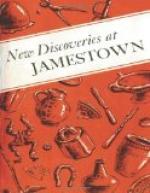[Illustration: Building A small boat at Jamestown about 1650. (Painting by Sidney E. King.)]
[Illustration: Boat-building tools found, all made before 1700.]
[Illustration: Earthenware vessels made at Jamestown between 1625 and 1640. The site of an early 17th-century pottery kiln was discovered on the island in 1955.]
[Illustration: Making pottery at Jamestown, about 1625-40. (Painting by Sidney E. King.)]
[Illustration: Artifacts found near the site of the Jamestown glasshouse which was in operation as early as 1608: A small melting pot, part of A working Hole, fragment from large melting pot, cullet (broken or refuse glass Shown in Lower left corner), and Green glass fragments (Lower center and Lower right).]
[Illustration: Blowing glass at Jamestown in 1608. (Conjectural sketch by Sidney E. King.)]
THE GLASSBLOWER
Glassblowers were working at Jamestown in 1608-09, and again in 1621-24. The trial glass they made in 1608 was sent to England—the first glass manufactured by Englishmen in the New World. The small glass fragments excavated at the furnace sites do not reveal what was produced, but probably nothing more complicated than window glass, bottles and vials, and plain drinking glasses. It is believed that the small glass factory at Jamestown was the first English “factory” in America.
THE BRICKMAKER AND TILEMAKER
Four brick kilns have been excavated. In two of them roofing tile and bricks were found. An iron spade, probably used in preparing the clay for brickmaking, was found in one of the kilns. The oldest kiln unearthed is believed to have been in use as early as 1625. Many brickmakers emigrated to Jamestown during the 1600’s.
THE LIMEBURNER
Four lime kilns were unearthed on the historic island, where oyster shells from the James River were burned and converted into lime by the limeburner. As early as 1610 “lymeburners” emigrated to Virginia, and thereafter many such workers came to the colony from England.
[Illustration: Four brick kilns have been excavated. The one Shown had five firing chambers. Roofing tiles were also made in the Jamestown brick kilns.]




